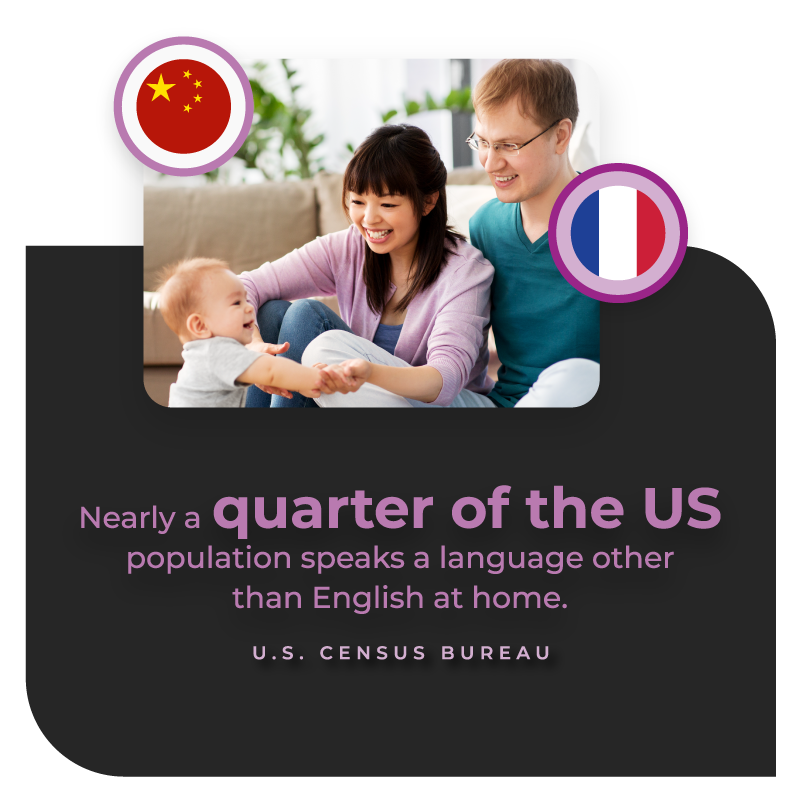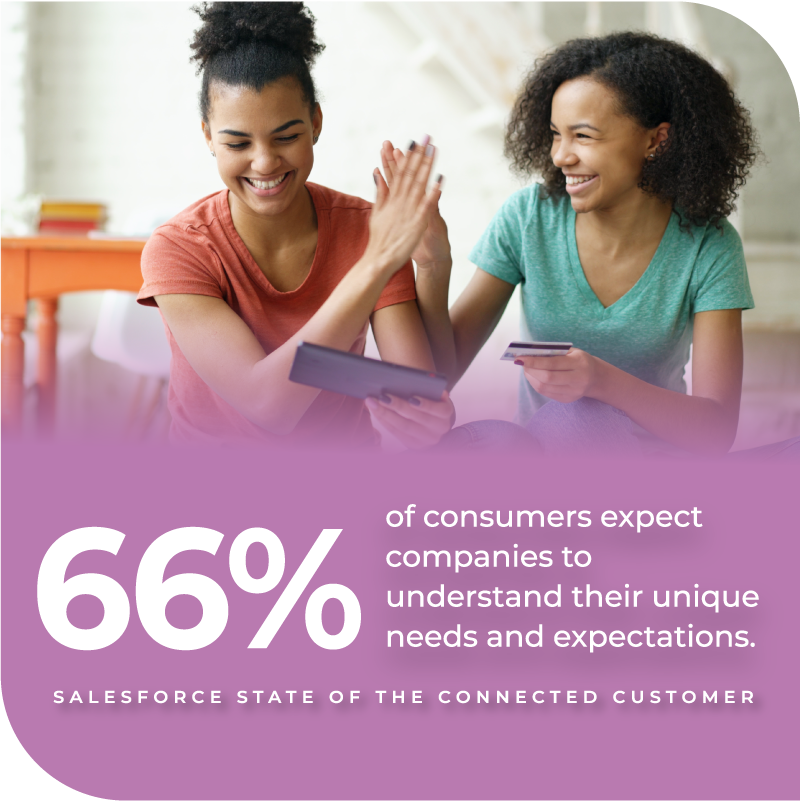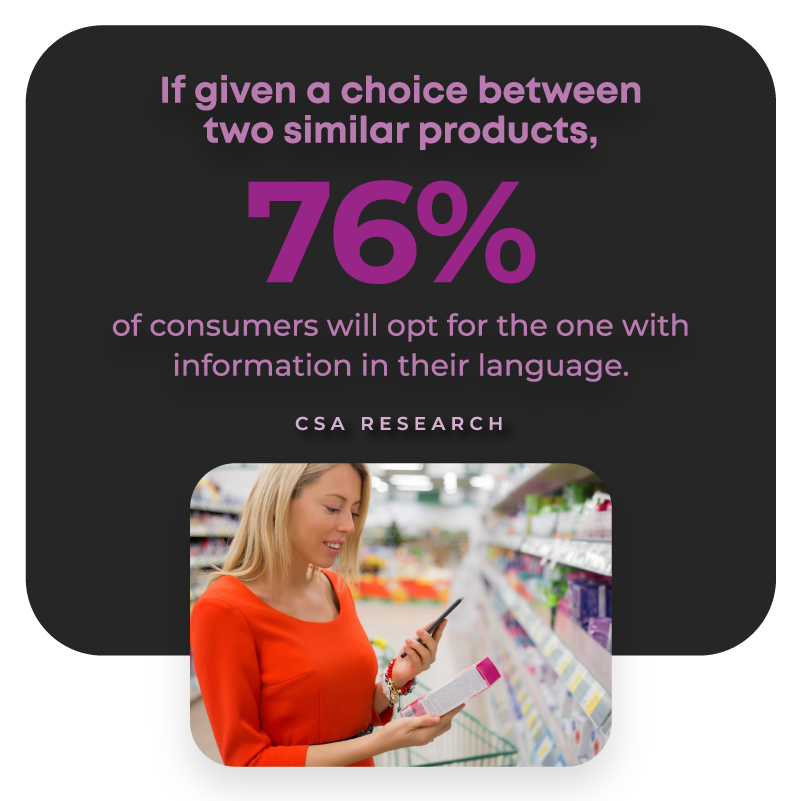State of Business Translation 2022

Delivering great service throughout the customer journey has always been an important way to gain a competitive edge. But lately, it’s gotten even more important, as customer expectations have never been higher.
Per Salesforce’s State of the Connected Customer, more than half of consumers say that the crises of the past couple of years have raised their standards for customer service. And 47% will stop buying from a company after having a subpar experience.
A big part of meeting these expectations is being able to effectively communicate with customers in whatever language they speak. This is especially true if your brand has its sights set on global expansion. After all, localization is key to successful expansion. And according to Salesforce, language is the most important consideration for localization.

But that doesn’t mean brands operating solely in the United States can get away with ignoring the importance of translation. After all, nearly a quarter of the population speaks a language other than English at home, with Spanish, Chinese, Tagalog, Vietnamese and Arabic being the top languages.
Why is fast, accurate translation a top priority for customer-centric businesses? And how are the tools businesses use to break down barriers improving and evolving? To answer those questions, let’s take a look at the state of business translation in 2022.
Consumers Expect Service in Their Native Language – and They Reward Brands That Offer It
Consumers don’t want to feel like they’re just another number. Instead, they want brands to treat them like valued individuals. In fact, 66% of consumers expect companies to understand their unique needs and expectations.
A big part of meeting these expectations is being able to communicate with customers, regardless of their preferred language.

Brands that successfully break down language barriers are better able to convert shoppers. According to CSA Research, if consumers are given the choice between buying two similar products, 76% will opt for the one with information in their language.
What’s more, brands that provide multilingual support are more likely to win repeat business. The same CSA Research study found that 75% of consumers are more likely to purchase from a brand again if they’re able to access customer care in their preferred language.
A growing number of consumers are seeking out service via digital channels, including chatbots, live chat, and messaging apps – among others. In order to meet the needs of modern consumers, brands must have a strategy in place to effectively communicate with them via their preferred channels, in their preferred languages.
Global Workforces Require Effective Translation for Optimal Collaboration

In the past, all members of a brand’s customer service team may have been based in the same office. But today, it’s becoming increasingly common for service teams to be geographically distributed. This is especially true for businesses that have expanded globally – or have plans to do so.
If a company has customer service agents based across the globe, it’s likely there are a number of different languages spoken internally. While this is a key advantage of a global team, it can also cause challenges when it comes to collaboration.
Consider this scenario. An Italian customer interacts with a customer service agent in Italy via live chat, and the agent opens a case in Salesforce. Both the chat and the case are in Italian. A week later, the customer reaches out via live chat again – but they’re connected with a customer service agent in the US that doesn’t speak Italian. The US agent checks out the chat transcript from the previous interaction, as well as the case, but they can’t read it because it’s in Italian. So, they have no context prior to interacting with the customer. And that means the customer has a frustrating, fragmented experience.
Brands with global workforces must provide fast, reliable translation for internal communication. This is an important way to improve internal collaboration. And, when geographically dispersed teams can more effectively collaborate, they’re better able to provide seamless experiences to customers.
Machine Translation Quality is Getting Better All the Time
As we’ve explored, a solid business translation strategy is essential for any brand looking to improve internal collaboration – and deliver great customer service experiences in any language. But how can brands break down language barriers both internally and externally?
There was a time when the only way to translate something from one language to another was to send it off to a translator, a process that was both costly and time-consuming.
Today, machines do the lion’s share of the work.
Machine translation isn’t exactly a new concept. During the Cold War, SYSTRAN was one of the first companies to develop machine translation to translate intelligence materials. Early machine translation was built on rule-based methods, which means it relied on rules developed by humans or from dictionaries to run translations.
While early machine translation was innovative for the time, there were problems with things like nuance, word reflection, and word order. In other words, things were often “lost in translation.” Plus, there were limits as far as what languages could and couldn’t be translated.
Today, machine translation still isn’t perfect. Remember when Amazon launched in Sweden last year and there were headlines about weird translation errors?
However, machine translation quality and speed are improving all of the time. Modern machine translation systems use algorithms that are trained to learn how to understand and more effectively translate natural language text. In other words, they’re trained to translate more like an actual human translator.
In fact, there are several leading translation engines available today, including Google Translate, DeepL, AWS, and Microsoft Translator. Each is constantly changing and evolving – and translations are getting faster, more accurate, and more natural.
It’s Getting Easier to Engage in Multilingual Interactions – Both Internally and With Customers
Machine translation is constantly improving. But the reality is, it can still be challenging to improve internal collaboration and deliver fast, accurate multilingual support at scale.
Sure, customer service agents can copy and paste text from emails, live chats and other digital communication channels into a translation engine. However, this is a time-consuming process – with plenty of room for error.
According to Salesforce’s State of Service report, over half of customer service professionals indicate case volume has increased. But oftentimes, resources have remained the same. That means reps must maximize every minute. A clunky translation process stands in the way of a rep’s ability to solve problems and delight customers in a timely manner.
Fortunately, there’s a better way.
Today, customer-centric brands looking to break down language barriers both internally and externally are using a business translation solution like Translation Studio from 1440. With Translation Studio, customer service teams can quickly and accurately translate just about anything in Salesforce – without having to leave the platform.
Translation Studio allows for better internal communication across a globally distributed workforce. For example, a customer service agent can add case details notes in their native language of German. Later on, when an agent in Mexico takes over the case, they can quickly translate these notes into Spanish. They’ll have an accurate picture of the communication that’s already happened with the customer – and be ready to pick up where the last agent left off.
Translation Studio also empowers brands to engage with consumers throughout the purchase journey – in their preferred language. For example, a customer service agent in the United States might get a live chat in Portuguese. The agent can translate the chat in real-time, compose their answer in English, and then translate it before hitting “respond.” Or, they can point the customer to a knowledge article for more information on a specific topic – translated to the customer’s preferred language. And they can do all of this without leaving Salesforce.
With the right translation solution, you’ll improve internal communication and collaboration – and start delighting more customers, regardless of language.
A Fast, Accurate Translation Solution is a Must for Any Brand
Increasingly, workforces are geographically distributed, with teams speaking myriad languages. At the same time, consumers have come to expect great services and experiences, regardless of their preferred language.
Thanks to improvements in machine translation and services like Translation Studio, it’s getting a whole lot easier for brands to improve internal collaboration – and meet consumers’ desire for in-language communication.
Ready to find out how Translation Studio from 1440 can help you break down language barriers and start translating just about anything in Salesforce? Request a demo to see Translation Studio in action.